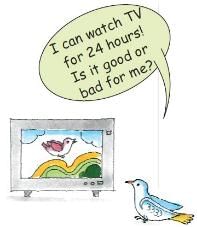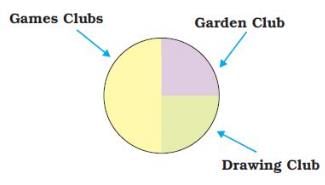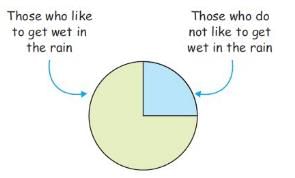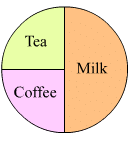NCERT Solutions for Class 4 Maths - Chapter 14 - Smart Charts
PAGE No. 162
Q.1.
i) Note the time you spend in front of a TV or radio every day. Do this for one week. The time spend in a week is ________ hours. So in a month you spend about 30 × ____ = ____ hours.
ii) Find out from your friends the time they spend in a week.
| How many hours they watch TV or listen to the radio (in a week) | Number of Children |
| More than 6 hours | |
| Six hours | |
| Five hours | |
| Four hours | |
| Three hours | |
| Two hours | |
| One hour | |
| Zero hour (do not watch) |
 Ans:
Ans:
i) Time spent in front of TV or radio every day = 1 hour
∴ Time spent in a week = 7×1 hour = 7 hours
Total time spent in a month = 30×1 hour = 30 hours
ii)
| How many hours they watch TV or listen to the radio (in a week) | Number of Children |
| More than 6 hours | 5 |
| Six hours | 7 |
| Five hours | 4 |
| Four hours | 10 |
| Three hours | 12 |
| Two hours | 15 |
| One hour | 8 |
| Zero hour (do not watch) | 1 |
PAGE No. 164
Q.1. Who is my friend? I’ve a friend with me always, In the nights and through the days. When I run he runs with me, Sometimes I lead, sometimes he. When it’s dark he can’t be seen, Do you know which friend I mean?
i) Read the poem carefully and answer these questions:
(a) Which word comes most often in the poem?
(b) Which letter has been used most?
(c) Which letter comes the least?
Ans.
i)
(a) The word ‘I’ comes most often in the poem.
(b) The letter ‘E’ has been used most in the poem.
(c) The letters ‘B’ and ‘V’ come the least in the poem.
Page No. 167
Q.1.

(a) How many children are acting in the drama?
(b) Which are more — children making the sets or those acting?
(c) What is being done by most of the children?
(d) How many children are collecting dresses?
Ans:
(a) 3 children are acting in the drama.
(b) Children who are acting are more in number than children who are making the sets.
(c) Most of the children are playing music.
(d) Two children are collecting dresses.
Page No. 168
Q.1. The Chapati Chart shows the number of children in different clubs.

From the picture we can see that:
(a) Half the children in the class take part in the Games Club.
(b) One fourth of the children are members of the Garden Club.
(c) The Drawing Club has one fourth of the children of the class.
If there are 200 students in the school, look at the above Chapati Chart and tell the number of members in each club:
- The Games Club has _________ members.
- The Garden Club has __________ members.
- There are __________ members in the Drawing Club.
Ans: Total students = 200
- Members in the Games Club = 200 ÷ 2 = 100
- Members in the Garden Club = 200 ÷ 4 = 50
- Members in the Drawing Club = 200 ÷ 4 = 50
Page No. 169
Q.1. Getting Wet in the Rain Who likes to get wet in the rain? A child made this Chapati Chart after asking his friends.

See the Chapati Chart and tell:
(1) How many children like to get wet in the rain?
(a) half
(b) one-fourth
(c) three-fourth
(2) How many children do not like to get wet in the rain?
(a) half
(b) one-fourth
(c) three-fourth
If the number of children in the class is 28, then tell the number of children
- who like to get wet in the rain ____________
- who do not like to get wet in the rain ___________
Ans.
(1) (c) three-fourth
(2) (b) one-fourth
Number of children in the class = 28
∴ Number of children who do not like to get wet in the rain = 28 ÷ 4 = 7
Number of children who like to get wet in the rain = 7 × 3 = 21
If the number of children in the class is 28, then tell the number of children
- who like to get wet in the rain 21
- who do not like to get wet in the rain 7
Page No 170:
Q.1. Tea, Coffee or Milk Some children were asked which of these they liked most — Tea, Coffee or Milk.
| The drink they like | Number of children |
| Milk | 20 |
| Coffee | 10 |
| Tea | 10 |
Total Number of children __________
Find out from the table:
- Children who like milk are 12/14 of the total children.
- Children who like coffee are 12/14 of the total children.
Show the liking for Tea, Coffee or Milk in a Chapati Chart.
Ans. Total number of children = 20 + 10 + 10 = 40
- Children who like milk are 12 of the total children.
- Children who like coffee are 14 of the total children.
Chapati Chart for tea, coffee and milk is given below:

|
26 videos|195 docs|34 tests
|
FAQs on NCERT Solutions for Class 4 Maths - Chapter 14 - Smart Charts
| 1. What is the purpose of Smart Charts? |  |
| 2. How can Smart Charts help in exam preparation? |  |
| 3. Are Smart Charts available for all subjects and classes? |  |
| 4. How can I access the Smart Charts for NCERT solutions? |  |
| 5. Can Smart Charts be used as a standalone study resource? |  |
















